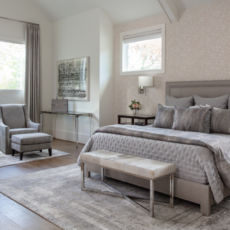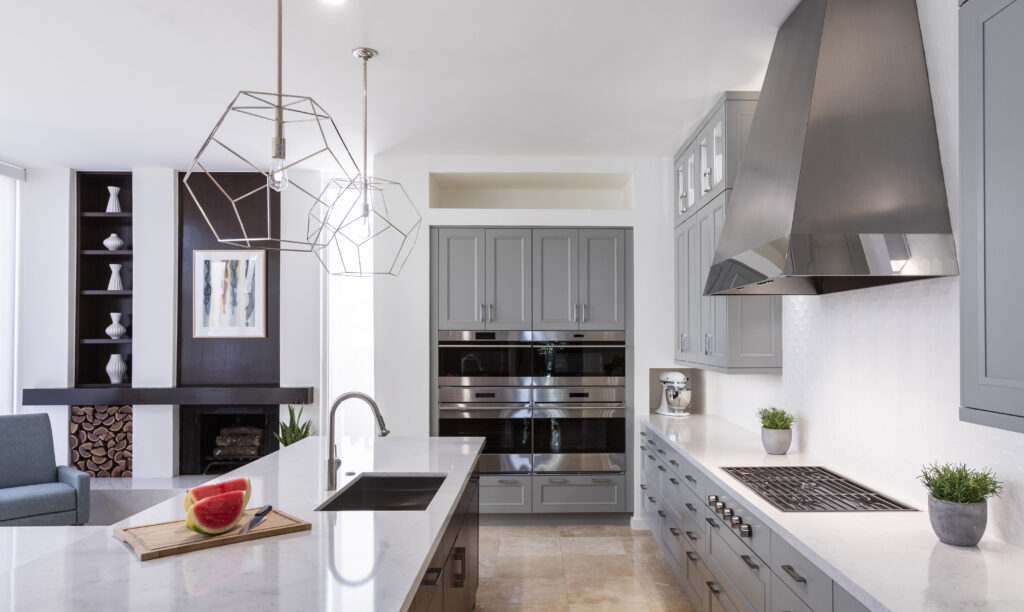
Décor by Pamela Hope Designs
Cabinetry hardware offers lots of options to update and style your home. Some clients opt to choose all new cabinetry and hardware at one time (such as in new construction or a large remodel), while some decide to update a room’s look with new cabinet pulls and knobs (and other niceties) while keeping the current cabinetry. Both approaches are fun. I love learning what clients like about certain hardware styles and their needs, and then helping to create a comprehensive look that is completely customized.
For a recent project, I recommended three combinations of hardware for my client. I personally enjoy thinking of cabinet hardware like jewelry and appreciate a good mix of pulls and knobs. However, this client dislikes cabinet knobs so we intentionally chose various pulls for the kitchen. All options were in stock with approximately a two-week delivery time. While an ample shipping and delivery timeline is to be expected, COVID-19 has added constraints on the supply chain that can result in lengthier projects. (When another hardware company experienced a COVID outbreak, the business closed for six weeks! Of course, people’s health comes first but imagine the backlog of orders the company had after being closed unexpectedly for a month and a half!) Once a client has approved selections, I order the products as soon as possible. Choosing the right hardware is not quite that straightforward.
One pitfall that we see do-it-yourselfers (DIYers) fall victim to is not measuring the “center-to-center of the drawer pull” that is being replaced. In short, each drawer pull has screw holes on either end used to screw the pull onto the cabinetry. If the distance between the center of one screw hole to the center of the other is not the same on your old and new drawer pulls, you’re left with ugly holes from the first set of pulls. When replacing hardware on cabinetry you already have, prevent this headache by finding new pulls with the same center-to-center measurement. (See our additional tips at the end of this blog post.)
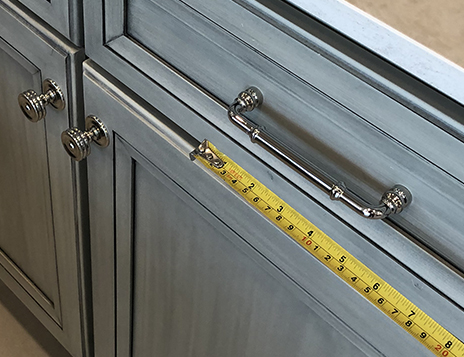
We continue to see the trend toward larger hardware and most people now start with seven-inch pulls. For this project, we selected hardware options within the five to seven-inch range, which would be large enough yet look modern and be easy to use. Through all my years of interior design, I’ve found that men hate tiny pulls that they can’t seem to get their fingers through. Cramming your fingers into too small of a drawer pull rates high on the frustration scale. To avoid that, I encourage clients to pay close attention to the pull selection process and I emphasize that just looking at a photograph of a kitchen, pantry, bath or laundry pull is not adequate. Buyers need to touch the pull to understand how it feels. Do four fingers fit nicely in the pull or does the pull feel too small? Are there any edges that feel rough or uncomfortable? These considerations are subjective but definitely important to remember when picking your cabinet pulls. Handling the pulls help identify the best option for each individual in the home.

Photos Courtesy of Baths of America
The shape of the pulls is another characteristic that plays into the selection with shapes ranging from more squared pulls with squared bases like the (above left) Mulholland pull from Baths of America in polished nickel to the soft rounded edges of the Kane pull also in satin nickel from Baths of America. While the above two pulls use a similar tone, the variation in edges and line types gives them quite a different look and feel.
Of course, how the pulls look with the style, size and finish of cabinetry is also important. The team at Pamela Hope Designs uses charts like the one below coupled with photographs from magazines and our other client projects to help clients visualize how the various elements will come together. The cabinets for this kitchen are being provided by Shannel Garland at K&N Sales.
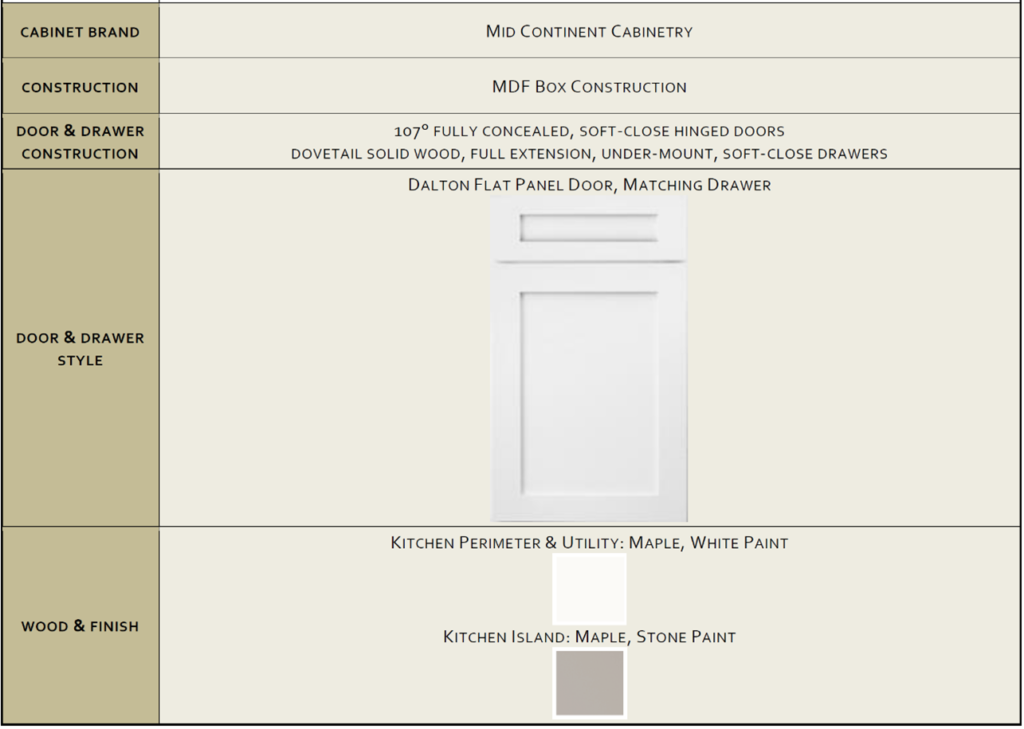
The next photograph is one that I took of a kitchen vignette while visiting the Baths of America gallery in Houston. (We love working with Chadney Alvarez on our plumbing and hardware needs!) Another trend that we’re seeing is a single pull used in both horizontal and vertical directions. This works well if you choose long cabinet pulls.
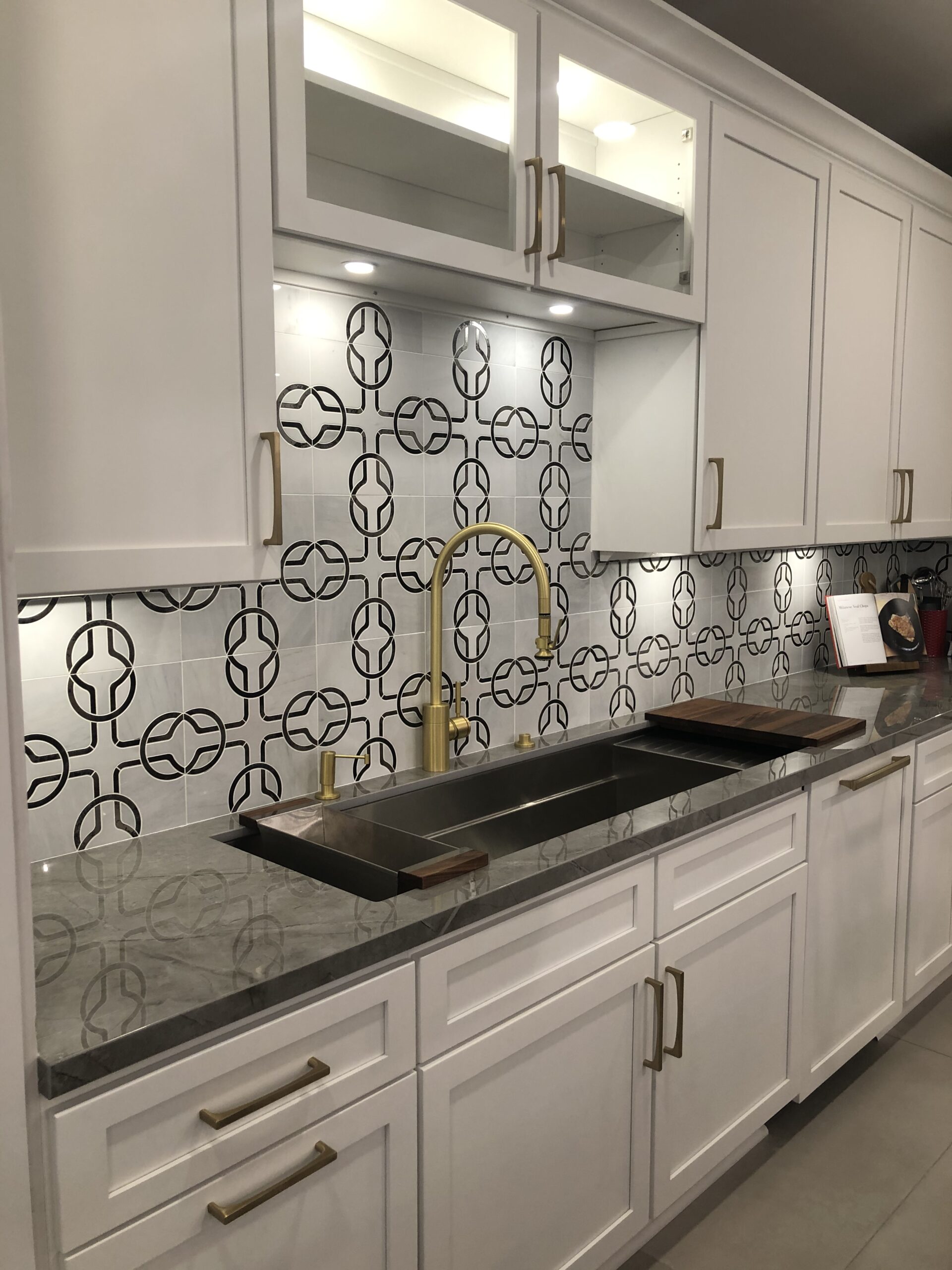
Kitchen Vignette at Baths of America
Embracing this trend, we thought using pulls vertically on cabinets and horizontally on drawers would look nice for this client, too. To mix it up, we suggested a cup pull for the trash and drawer beneath the ovens on the oven/sink side, one cup pull for the spice pull-out on the cooktop side and four cup pulls for the island. The two top drawers don’t leave enough space for cup pulls so I suggested regular pulls there. Since the bottom drawers are much larger, cup pulls look best there. I think this is a nice mix of cabinetry hardware for visual appeal.
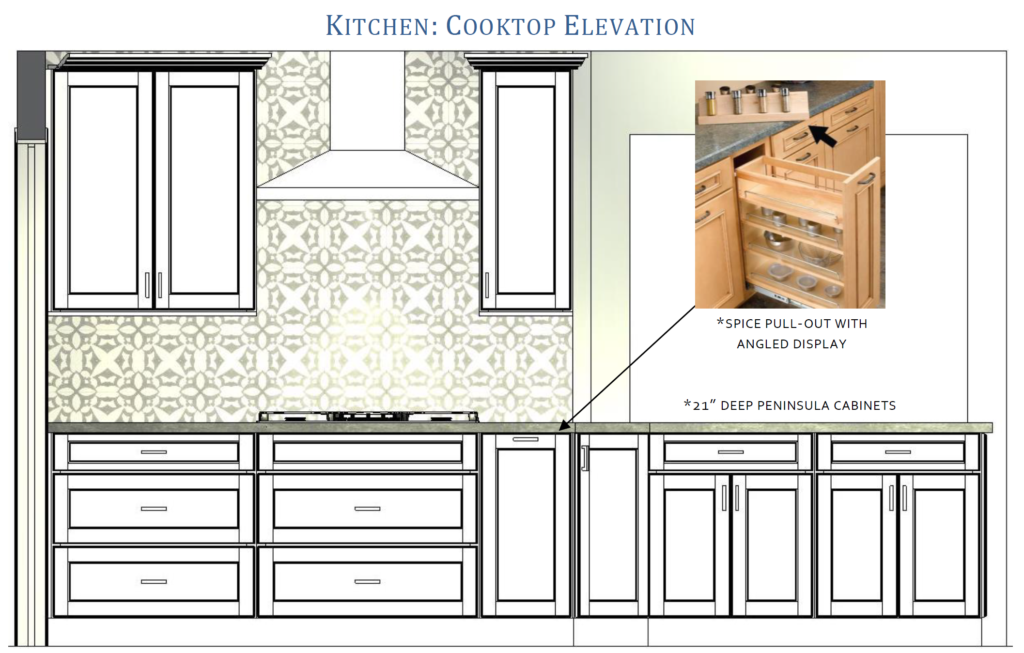
I have also included below a mock-up of where we needed to select a smaller piece of hardware because the cabinet front is only 2.25 inches high. It’s a best practice to take note of smaller doors and drawers because you might need to install a knob or a smaller pull. Without this adjustment, the oversized pull can look off scale compared to the other cabinets and pulls in the same area or it may not fit at all.
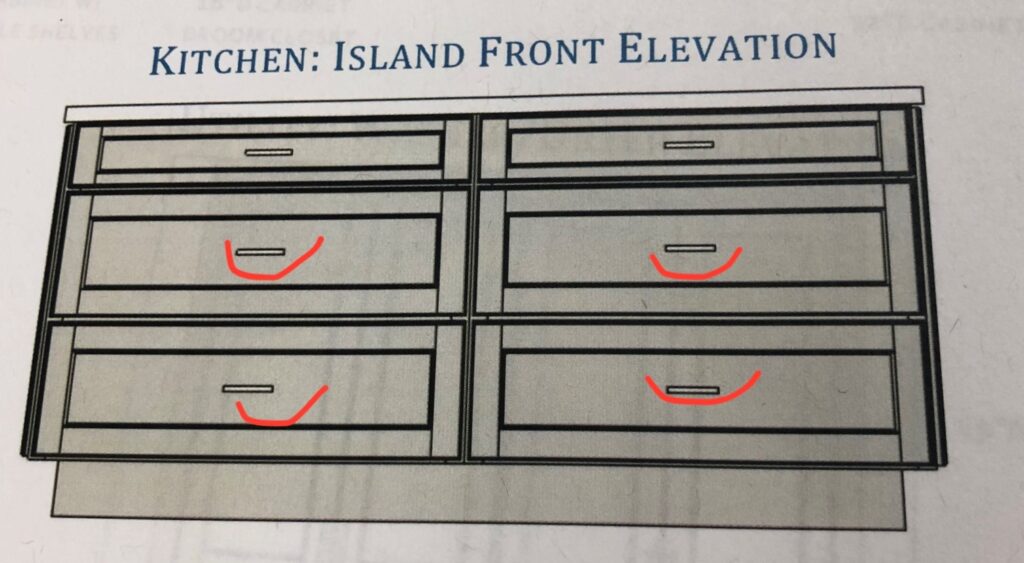
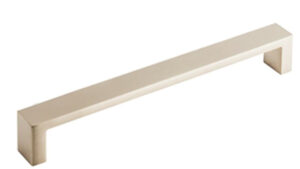
Pull by Top Knobs, Available from Baths of America
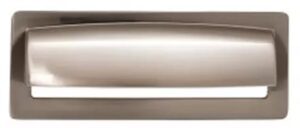
Lynwood Hollin Pull in brushed satin nickel
With the type and placement of the cabinet hardware decided, the next step was suggesting simple designs. Luckily, all three of our favorites were available in a satin nickel finish that works well with the kitchen faucet previously selected. After sharing these three options with the client, the final selection for a combination of pulls and bin pulls in satin nickel was made. The thinner pull is the Sanctuary Ii Modern Metro 7” Center to Center Bar Pull, which again will be used in both vertical and horizontal placements throughout the kitchen. We paired this slender pull with the Lynwood Hollin Recessed Pull, which will be used on lower drawers that hold heavy pots and pans as well as trash pull outs since those need a more substantial pull to support the weight of the contents inside. We’re looking ahead to this installation and to sharing with our followers how the final project unfolds.
Before I wrap up, I’d like to share a few more quick tips on installing cabinet hardware (both pulls and knobs) and how to address some common obstacles as well as unique ways to use extra knobs.
- If the screw hole is too small, it’s an easy fix with a drill to enlarge the hole and screw in the new hardware.
- If the screw hole is too large, fill the hole with wood putty, touch up the paint and drill a new hole to fit the new hardware.
- If the screw holes are too widely or narrowly spaced for the new pull, see the above tip. Use wood putty to close up the holes and touch up the paint. If it’s a difficult surface to touch up (antiqued or stained cabinets can be difficult to blend nicely), look for a backplate piece of hardware to cover the messy part or select a knob or pull that is larger than the original. Note: You often do find a ring, scratched or blemished area on the surface from the old hardware when removing it. It’s often a good idea to select new hardware that is slightly larger to cover that area.
- When using knobs, people may want to screw them directly into a wall or a board (to make a peg rack for instance) but find that the knobs have a flat end. Sometimes you can remove the fastener and replace it with a double-headed screw that allows you to screw into the knob and then screw the knob into the wall or your piece of wood.
- Some knobs that I have on hand have a bolt with a few small washers and a nut on them. They are also very long. These often have to be trimmed so I have my installer cut them for me. Once they are the right size, I can screw them into my drawer, cabinet or piece of wood or peg rack and use the nut to secure them. When creating a peg rack or something to hang on the wall, this may create a small projection from the back. A pair of sawtooth hangers should help compensate for that and allow you to hang your rack flush against the wall. Using a hanger on each end also makes it more secure.
- If you have extra knobs from past projects or a great find at an antique shop, use a single knob on a medicine cabinet, the top drawer of a desk or a stand-alone cabinet. Combine groups of single knobs in a small area like a butler’s pantry, utility room or linen cabinet for an artistic flair. I’ve also mounted a few to make cute towel holders.


